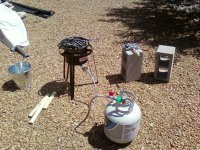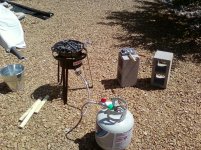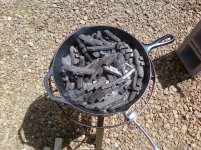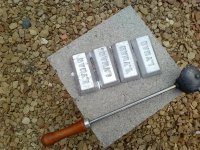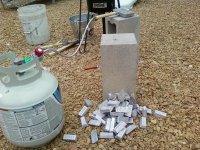Okay, if newb like me can make this work, you can too. What are you waiting for?  Get get some stuff and get to work!
Get get some stuff and get to work!
Smelt Setup before I start up.

I went to Wally World (I hate that place) to get a cast iron pot but when I saw the skillet, I thought it would be convenient to have a handle and a pour spout.
Okay, I'm a newb. You can't handle a skillet that weighs thirty pounds with your hands. NO gloves on the planet and protect your hands from 700+ degrees of heat. Ain't happenin'.
I shoulda got the bigger pot.
That said, however, this setup seemed to work just fine. It's low enough to the ground so that I don't have to worry about everything falling over and high enough so I'm not no my knees working. Bayou Classic makes a tall stand burner and I considered getting it but deferred to this one for a bit of added stability. I think, however, I would have been fine with the tall one. It's a very well-built piece of equipment.
After the fires are stoked and the lead had just started to melt.

This first batch was 18 pounds. I had weighed out two rolls of 50/50 bar solder plus this lead in order to get to 20 pounds. I intended to add the bar solder after fluxing and, according to the recipe in the Lyman manual, I would have a harder alloy.
Then I got so involved in what I was doing, I forgot to add the solder until I had poured all but the last four ingots out of this first melt! Oh, well. As I thought about it, I figured that it was a good thing, after all because in the smaller casting furnace, I'll have more control over the recipe and can customize each one mo' betta.'
More below:
Smelt Setup before I start up.
I went to Wally World (I hate that place) to get a cast iron pot but when I saw the skillet, I thought it would be convenient to have a handle and a pour spout.
Okay, I'm a newb. You can't handle a skillet that weighs thirty pounds with your hands. NO gloves on the planet and protect your hands from 700+ degrees of heat. Ain't happenin'.
I shoulda got the bigger pot.
That said, however, this setup seemed to work just fine. It's low enough to the ground so that I don't have to worry about everything falling over and high enough so I'm not no my knees working. Bayou Classic makes a tall stand burner and I considered getting it but deferred to this one for a bit of added stability. I think, however, I would have been fine with the tall one. It's a very well-built piece of equipment.
After the fires are stoked and the lead had just started to melt.
This first batch was 18 pounds. I had weighed out two rolls of 50/50 bar solder plus this lead in order to get to 20 pounds. I intended to add the bar solder after fluxing and, according to the recipe in the Lyman manual, I would have a harder alloy.
Then I got so involved in what I was doing, I forgot to add the solder until I had poured all but the last four ingots out of this first melt! Oh, well. As I thought about it, I figured that it was a good thing, after all because in the smaller casting furnace, I'll have more control over the recipe and can customize each one mo' betta.'
More below:
Attachments
Last edited:

